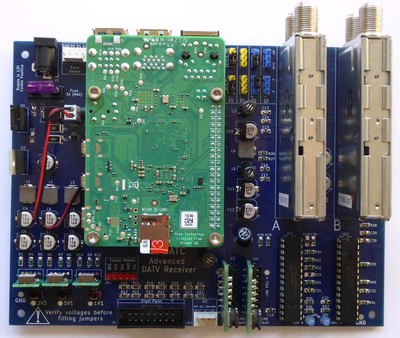Difference between revisions of "Winter Hill receiver project"
| Line 19: | Line 19: | ||
• The 4 received transport streams (TS) can be sent to any location using UDP protocol | • The 4 received transport streams (TS) can be sent to any location using UDP protocol | ||
| − | • Transport streams are displayed either locally or remotely using VLC | + | • Transport streams are displayed either locally on the RPi4, or remotely using VLC |
• Receive commands can come from various sources, including QO-100 QuickTune designed by M0DTS | • Receive commands can come from various sources, including QO-100 QuickTune designed by M0DTS | ||
| Line 55: | Line 55: | ||
==Documentation== | ==Documentation== | ||
| − | Raspberry Pi4 SD Card Building and Software Installation Manual (contains | + | Raspberry Pi4 SD Card Building and Software Installation Manual (contains RPi4 software download details) |
Operation Manual | Operation Manual | ||
Revision as of 15:29, 14 March 2021
WinterHill
The WinterHill receiver project by Brian G4EWJ with hindrance and occasional help from Mike G0MJW. It uses the BATC Advanced receiver hardware.
Features
• WinterHill is a 4 channel DVB-S/S2 receiver based on the BATC Advanced Receiver PCB
• The main components are a Raspberry Pi 4 (RPi4), 2 x FTS433x NIMs, 2 x PICs and 2 optional LNB PSU boards
• The PICs are programmed in-circuit automatically during software installation
• The RPi4 software is based on LongMynd by M0HMO
• The RPi4 interfaces to each NIM using a PIC, rather than an FT2232H USB module
• The 4 received transport streams (TS) can be sent to any location using UDP protocol
• Transport streams are displayed either locally on the RPi4, or remotely using VLC
• Receive commands can come from various sources, including QO-100 QuickTune designed by M0DTS
• The highest symbol rate is limited by the speed of the serial connections between devices and is about 10M bit/s per NIM. E.g. the QO-100 beacon at SR1500 FEC4/5 (2.4Mbps) and a terrestrial repeater at SR4000 FEC7/8 (7Mbps) should be OK.
• Currently, the lowest symbol rate that can be received is 66kS
• WinterHill is named in memory of Brian G3SMU, who was a huge presence on ATV and microwaves from his Winter Hill QTH in Lancashire, North-West England
Timeline
December 2020 - Currently the project is at the design phase with a proof of concept receiver working on breadboard hardware.
February 2021 - beta testing in progress
March 2021 - First production PCBs expected
Hardware
The PCB design by Mike G0MJW is based on a completely new concept, BATC Advanced DATV Receiver, supporting two SERIT tuners with an integrated Raspberry PI4 and PICs. No USB module is required. This supports 4 simultaneous receivers in either a set top box mode, with the PI desktop, or headless, or a combination of these.
Version 0.1
Feasibility design which worked fine
Version 0.2
A prototype that was also built by several beta testers. Two pin programming jumper instead of 3 pin and didn't fit in the box.
Version 1
First general release PCB - Likely release March 2021
Documentation
Raspberry Pi4 SD Card Building and Software Installation Manual (contains RPi4 software download details)
Operation Manual
PC Control and Viewing Utilities Manual
Software
PC Control and Viewing Software
